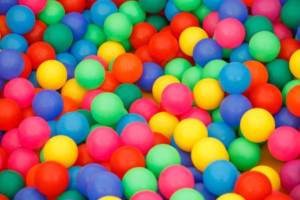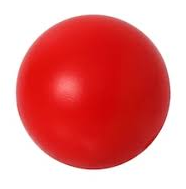Science > Mathematics > Statistics and Probability > Probability > Problems Based on Selection of Balls
In the last few articles, we have seen to solve problems based on tossing of coins, throwing dice, and selecting numbered cards. In this article, we shall study the problems to find the probability involving the draw of a single ball from a collection of identical but different coloured balls. e.g. An urn contains 9 red, 7 white, and 4 black balls. All balls are identical. If one ball is drawn at random from the urn. Find the probability that of getting a red ball.

Problems based on the Draw of a Single Ball:
Example – 01:
An urn contains 9 red, 7 white, and 4 black balls. All balls are identical. If one ball is drawn at random from the urn. Find the probability that
Solution:
| 9 R | 7W | 4 B |
Total = 9 + 7 + 4 = 20
There are 20 balls in the urn
one ball out of 20 can be drawn by 20C1 ways
Hence n(S) = 20C1 = 20
a) a red ball
Let A be the event of getting a red ball
There are 9 red balls in the urn
1 red ball out of 9 red balls can be drawn by 9C1 ways
∴ n(A) = 9C1 = 9
By the definition P(A) = n(A)/n(S) =9/20
Therefore the probability of getting a red ball is 9/20.
b) a white ball
Let B be the event of getting a white ball
There are 7 white balls in the urn
1 white ball out of 7 white balls can be drawn by 7C1 ways
∴ n(B) = 7C1 = 7
By the definition P(B) = n(B)/n(S) =7/20
Therefore the probability of getting a white ball is 7/20.
c) a black ball
Let C be the event of getting a black ball
There are 4 black balls in the urn
1 black ball out of 4 black balls can be drawn by 4C1 ways
∴ n(C) = 4C1 = 4
By the definition P(C) = n(C)/n(S) = 4/20 = 1/5
Therefore the probability of getting a black ball is 1/5.
d) not a red ball
Let D be the event of getting not a red ball
There are 7 + 4 = 11 non-red balls
1 non-red ball out of 11 non-red balls can be drawn by 11C1 ways
∴ n(D) = 11C1 = 11
By the definition P(D) = n(D)/n(S) = 11/20
Therefore the probability of getting not red ball is 11/20
e) not a white ball
Let E be the event of getting not a white ball
There are 9 + 4 = 13 non-white balls
1 non-white ball out of 13 non-white balls can be drawn by 13C1 ways
∴ n(E) = 13C1 = 13
By the definition P(E) = n(E)/n(S) = 13/20
Therefore the probability of getting not white ball is 13/20
f) not a black ball
Let F be the event of getting not a black ball
There are 9 + 7 = 16 non-black balls
1 non-black ball out of 16 non-black balls can be drawn by 16C1 ways
∴ n(F) = 16C1 = 16
By the definition P(F) = n(F)/n(S) = 16/20 = 4/5
Therefore the probability of getting not a black ball is 4/5.
g) a red ball or a black ball
Let G be the event of getting not a red ball
There are 9 + 4 = 13 red or black balls
1 red or a black ball out of 13 can be drawn by 13C1 ways
∴ n(G) = 13C1 = 13
By the definition P(G) = n(G)/n(S) = 13/20
Therefore the probability of getting a red ball or a black ball is 13/20.
h) a red ball or a white ball
Let H be the event of getting a red ball or a white ball
There are 9 + 7 = 16 red or white balls
1 red or a white ball out of 16 can be drawn by 16C1 ways
∴ n(H) = 16C1 = 16
By the definition P(H) = n(H)/n(S) = 16/20 = 4/5
Therefore the probability of getting a red ball or a white ball is 4/5.
i) a black ball or a white ball
Let J be the event of getting a black ball or a white ball
There are 4 + 7 = 11 black or white balls
1 black or a white ball out of 11 can be drawn by 11C1 ways
∴ n(J) = 11C1 = 11
By the definition P(J) = n(J)/n(S) = 11/20
Therefore the probability of getting a black ball or a white ball is 11/20.
Example – 02:
An urn contains 9 red, 7 white, and 4 black balls. All balls are identical. Two balls are drawn at random from the urn. Find the probability that
Solution:
| 9 R | 7 W | 4 B |
Total = 9 + 7 + 4 = 20
There are 20 balls in the urn
Two balls out of 20 can be drawn by 20C2 ways
Hence n(S) = 20C2 = 10 x 19
a) both red balls
Let A be the event of getting both red balls
There are 9 red balls in the urn
2 red balls out of 9 red balls can be drawn by 9C2 ways
∴ n(A) = 9C2 = 9 x 4
By the definition P(A) = n(A)/n(S) = (9 x 4)/(10 x 19) = 18/95
Therefore the probability of getting both red balls is 18/95
b) no red ball
Let B be the event of getting no red ball
There are 7 + 4 = 11 non-red balls in the urn
2 red balls out of 11 non-red balls can be drawn by 11C2 ways
∴ n(B) = 11C2 = 11 x 5
By the definition P(B) = n(B)/n(S) = (11 x 5)/(10 x 19) = 11/38
Therefore the probability of getting no red ball is 11/76
c) atleast one red ball
Let C be the event of getting atleast one red ball
Hence C is the event of getting no red ball
There are 7 + 4 = 11 non-red balls in the urn
2 non-red balls out of 11 non-red balls can be drawn by 11C2 ways
∴ n(C) = 11C2 = 11 x 5
By the definition P(C) = n(C)/n(S) = (11 x 5)/(10 x 19) = 11/38
Now, P(C) = 1 – P(C) = 1 – 11/38 = 27/38
Therefore the probability of getting atleast one red ball is 27/38
d) exactly one red ball
Let D be the event of getting exactly one red ball i.e. one red and 1 non red ball
There are 9 red and 7 + 4 = 11 non-red balls in the urn
2 red balls out of 11 non-red balls can be drawn by 11C2 ways
∴ n(D) = 9C1 x 11C1 = 9 x 11
By the definition P(D) = n(D)/n(S) = (9 x 11)/(10 x 19) = 99/190
Therefore the probability of getting exactly one red ball is 99/190.
e) at most one red ball
Let E be the event of getting at most one red ball There are two possibilities
Case – 1: Getting no red ball and two non-red balls or
Case – 2: Getting 1 red ball and 1 non-red ball
There are 9 red and 7 + 4 = 11 non-red balls in the urn
∴ n(E) = 9C0 x 11C2 + 9C1 x 11C1 = 1 x 11 x 5 + 9 x 11 = 55 + 99 = 154
By the definition P(E) = n(E)/n(S) = 154/(10 x 19) = 77/95
Therefore the probability of getting at most one red ball is 77/95.
f) one is red and other is white
Let F be the event of getting one red and one white ball
There are 9 red and 7 white balls in the urn
∴ n(F) = 9C1 x 7C1 = 9 x 7
By the definition P(F) = n(F)/n(S) = (9 x 7)/(10 x 19) = 63/190
Therefore the probability of getting one red and other white ball is 63/190
g) one is red and other is black
Let G be the event of getting one red and one black ball
There are 9 red and 4 black balls in the urn
∴ n(G) = 9C1 x 4C1 = 9 x 4
By the definition P(G) = n(G)/n(S) = (9 x 4)/(10 x 19) = 18/95
Therefore the probability of getting one red and other black ball is 18/95
h) one is white and the other is black
Let H be the event of getting one white and one black ball
There are 7 white and 4 black balls in the urn
∴ n(H) = 7C1 x 4C1 = 7 x 4
By the definition P(H) = n(H)/n(S) = (7 x 4)/(10 x 19) = 14/95
Therefore the probability of getting one white and other black ball is 14/95.
i) both are of same colour
Let J be the event of getting balls of same colour.
i.e. both are red or both are white or both are black
There are 9 red, 7 white, and 4 black balls in the urn
∴ n(J) = 9C2 + 7C2 + 4C2 = 9 x 4 + 7 x 3 + 2 x 3 = 36 +21 + 6 = 63
By the definition P(J) = n(J)/n(S) = 63/(10 x 19) = 63/190
Therefore the probability of getting both balls of same colour is 63/190
j) both are of not of the same colour
Let K be the event of getting balls not of the same colour.
Hence K is the event of getting the balls of same colour
i.e. both are red or both are white or both are black
There are 9 red, 7 white, and 4 black balls in the urn
∴ n(K) = 9C2 + 7C2 + 4C2 = 9 x 4 + 7 x 3 + 2 x 3 = 36 +21 + 6 = 63
By the definition P(K) = n(K)/n(S) = 63/(10 x 19) = 63/190
Now, P(K) = 1 – P(K) = 1 – 63/190 = 127/190
Therefore the probability of getting both balls of not of the same colour is 127/190.
k) both are red or both are black
Let L be the event of getting both red or both black balls.
There are 9 red and 4 black balls in the urn
∴ n(L) = 9C2 + 4C2 = 9 x 4 + 2 x 3 = 36 + 6 = 42
By the definition P(L) = n(L)/n(S) = 42/(10 x 19) = 21/95
Therefore the probability of getting both red or both black balls is 21/95.
In the next article, we shall study some basic problems of probability based on the drawing of two or more balls from a collection of identical coloured balls.

2 replies on “Problems Based on Selection of Balls”
There’s a typo in most denominators. It’s 20×19 instead of 10×19. Thank you for the examples. Great and quick recap!
20C2 = (20!)/[(2!) x (20-2)!]
20C2 = (20!)/[(2!)x (18!]
20C2 = 20 x 19 x (18!)/[(2 x 1)x (18!)]
20C2 = 10 x 19